Porto-North-Portugal.com
The best independent guide to north Portugal
Porto-North-Portugal.com
The best independent guide to north Portugal
The Beira Alto region of North East Portugal: an independent travel guide for 2026
Stretching from the last vineyards of the Douro to the plains of the Spanish border lies the Beira Alta, one of Portugal’s most historic and least-visited regions. This is a land of harsh beauty and profound tranquillity, where fortified hilltop towns stand as silent guardians over a timeless landscape.
For centuries, this was Portugal's volatile frontier, a frontline in the nation's long struggle for independence. This embattled history is carved into the very stone of the region, leaving behind a remarkable legacy of military architecture. You can explore the formidable walls of Trancoso, witness the revolutionary star-fort design of Almeida, or climb to the hauntingly beautiful ruins of Castelo Rodrigo.
Beyond the fortifications, the Beira Alta unfolds into a vast panorama of rolling granite hills, ancient forests, and fields divided by stone walls. Life here moves to an unhurried rhythm, dictated by the seasons rather than the demands of tourism. This distance from the modern world is central to the region's appeal, offering a glimpse into a corner of Portugal that remains deeply connected to its past.
For the traveller seeking to escape the well-trodden routes, the Beira Alta is a revelation. It is a destination for unhurried road trips along empty highways, for discovering immense historical sites without the crowds, and for experiencing the genuine warmth of communities that have not been reshaped by tourism.
This guide provides everything you need to explore the historic towns of the Beira Alta, helping you plan your journey through one of Portugal’s most rewarding regions.
Highlights of eastern Beira
Trancoso - Step back in time within the formidable granite walls of Trancoso. This beautifully preserved medieval town invites you to walk along its complete circuit of fortifications, offering commanding views before you explore the maze of cobbled lanes and discover its rich Jewish heritage within.
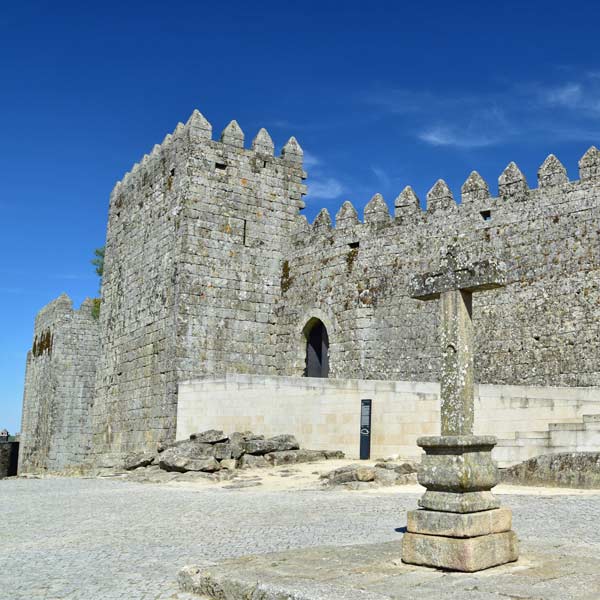
Almeida - One of the world's most impressive examples of a star fort. The entire town is encased within a massive system of bastions and moats, creating a perfect twelve-pointed star that represents the pinnacle of 17th-century military engineering.

Castelo Rodrigo - A hauntingly beautiful village perched on an isolated hilltop with panoramic views across the plains to Spain. Wander through the silent, cobbled streets of this tiny hamlet, passing ancient houses and a medieval church, to reach the dramatic ruins of its historic castle.
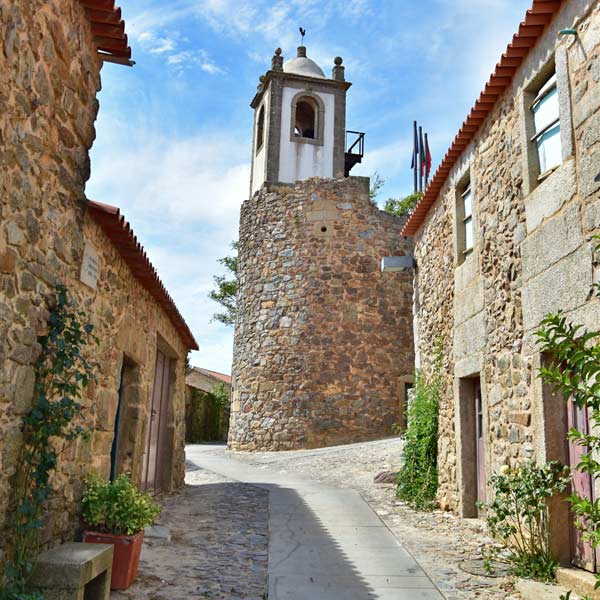
Castelo de Marialva - The spectacular and sprawling ruins of a once-powerful medieval stronghold. The remains of Marialva's castle and the abandoned village within its walls dominate a commanding hilltop, powerfully evoking the rise and fall of a frontier settlement.
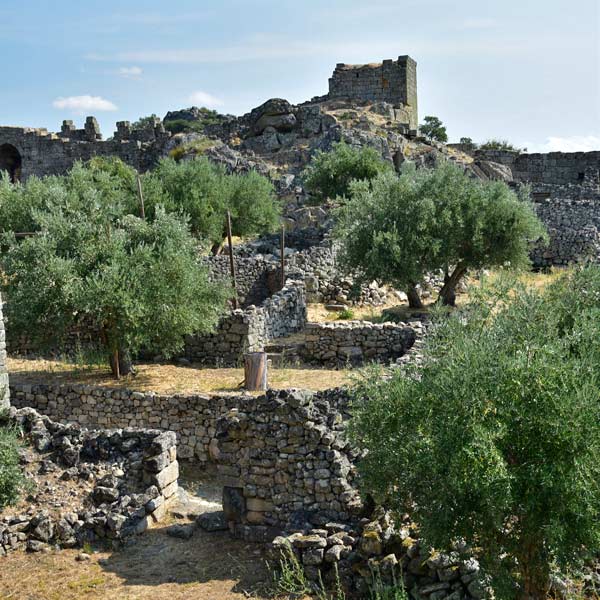
Linhares - A perfectly preserved granite village nestled in the foothills of the Serra da Estrela mountains. Linhares is famed for its uniform stone houses, ancient Romanesque streets, and the striking profile of its mountain-top castle, giving it an authentic and untouched character.
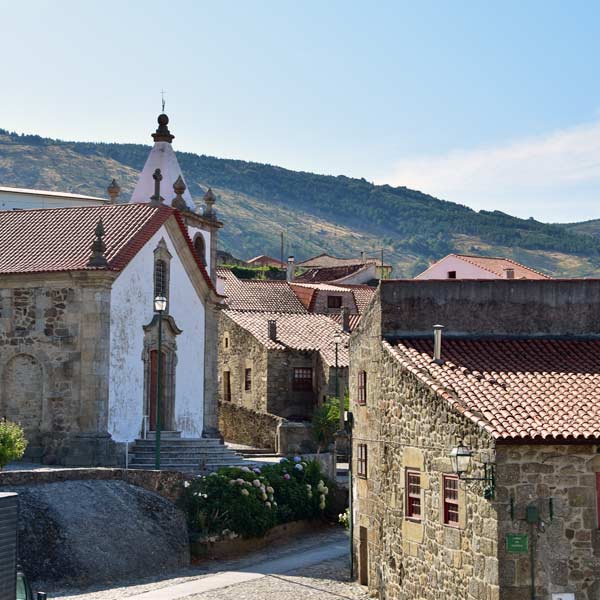
Note: While exploring north-eastern Portugal you must definitely include Monsanto, the Serra da Estrela mountains and the city of Viseu, but these are not covered by this article.
Related articles: Monsanto - The Serra da Estrela
Touring the Beira Alta: A Suggested Itinerary
The historic towns and vast landscapes of the eastern Beira Alta are ideally explored on a multi-day road trip. The following is a suggested six-day itinerary designed to showcase the region's diverse highlights, from formidable border fortresses to charming mountain villages and the stunning scenery of the Upper Douro.
Day 1: The Medieval Heartlands
Focus on the magnificent castles of Trancoso and Marialva. The smaller, triangular castle of Penedono can also be included if you have time.
Day 2: Frontier Fortresses
Discover the two most famous fortified towns: the star-shaped fortress of Almeida and the picturesque hilltop village of Castelo Rodrigo.
Day 3: Mountain Landscapes
Explore the charming granite village of Linhares before visiting the highest city in Portugal, Guarda. Alternatively, dedicate the day to a scenic drive through the heart of the Serra da Estrela mountains.
Day 4: The Regional Capital
A day dedicated to discovering the historic city of Viseu, with its magnificent cathedral and renowned Grão Vasco Museum.
Day 5: The Upper Douro & Prehistoric Art
Head north to the town of Vila Nova de Foz Côa, the centre for visiting the region's famous prehistoric rock art, set against the dramatic backdrop of the Upper Douro valley.
Day 6: Portugal's Most Unique Village
A day trip south to visit the incredible boulder-strewn village of Monsanto. While this involves a long drive, its unique character makes it a worthwhile finale to your tour.
Important: A Car is Essential
To get the most from the Beira Alta, a car is required. The region's sights are spread across wide distances, and public transport is extremely limited, making driving the only practical way to follow an itinerary like this.
The interactive map below shows the location of each of these destinations. (Note: Zoom in and out to see all of the markers).
Legend: 1) Day 1 2) day 2 3) day 3 4) Day 4 5) day 5
Choosing Your Base in the Beira Alta
Choosing the right base is key to exploring the vast Beira Alta. The ideal location offers a balance between a central position to minimise driving times and having enough amenities for a comfortable stay. While there are several options, some are significantly more practical than others.
Trancoso (The Best Overall Base)
For its central location and historic character, Trancoso is the best choice for a base from which to explore the entire region. It is a charming town with a good selection of restaurants and services for visitors. Crucially, it sits near the crossroads of the main IP2 and A25 highways, providing excellent road connections for day trips in every direction.
Viseu (The Largest City)
As the region's largest city, Viseu offers the widest selection of hotels, restaurants, and shops. However, it is located on the far western edge of the Beira Alta, meaning day trips to eastern sights like Almeida and Castelo Rodrigo will involve significantly longer drives. It is a good option if you prefer a city environment and don't mind the extra travel time.
Guarda (A High-Altitude Option)
Portugal's highest city has a fascinating historic centre and offers a different perspective on the region. Beyond its historic core, however, the city has expanded with extensive modern development and lacks the consistent charm of Trancoso as a holiday destination.
Almeida (For a One-Night Stop)
The fortified town of Almeida is incredibly atmospheric and makes for a memorable one-night stop. However, its remote eastern location and limited services make it less practical as a base for an entire trip.
The town of Vila Nova de Foz Côa is characterless, and its only a 35-minute drive from Trancoso.
Towns of the Beira region
Trancoso
Trancoso is a delightful medieval town, recognised as one of Portugal's 12 Historic Villages (Aldeias Históricas de Portugal). Its historic centre has barely altered since its heyday in the 13th century and offers a vivid glimpse into Portugal's medieval past. King Dinis married here in 1288 and presented the town as a dowry to his 12-year-old bride, cementing Trancoso's place in royal history.
As with many hills in Beira, a mighty stone castle was constructed on the summit of Trancoso's hill. The Castelo de Trancoso is one of the largest and best-preserved medieval castles of the region, boasting 15 towers and two gates. One of these, the Porta d'El Rei, is steeped in legend, associated with the tale of Saint Barbara.
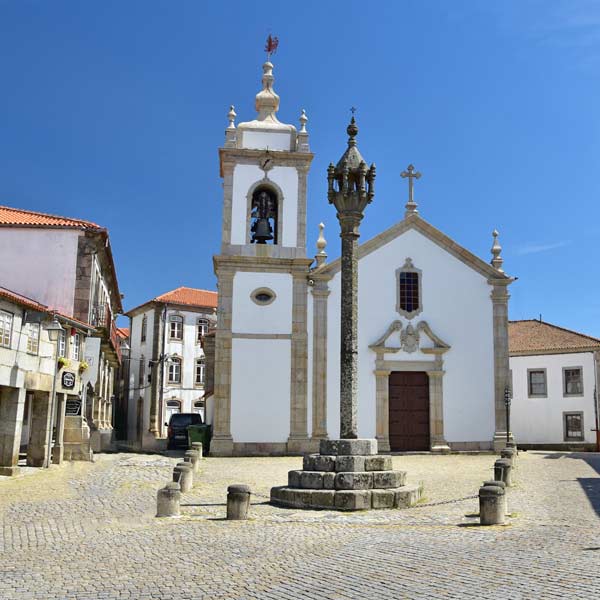
The Praça Dom Dinis with the town’s Pillory in front of the Igreja de São Pedro church
At the heart of the town lies the pretty Praça Dom Dinis plaza, while ancient walls encircle the historic quarter. These fortifications bear witness to Trancoso's strategic importance and its role as a significant commercial center in the Middle Ages. The town hosted large fairs that attracted merchants from various regions, contributing to its prosperity and cultural diversity.
Trancoso's medieval Jewish heritage is evident in its well-preserved Jewish quarter and a former synagogue, testimony to the significant Jewish population that once thrived here.
This characterful town takes around 2-3 hours to explore thoroughly and offers visitors a journey through history with its well-preserved architecture and storied past. Trancoso is also an excellent base for further exploration of the Beira region, with excellent roads in the surrounding area.

It is possible to walk around the town walls of Trancoso
Castelo Rodrigo
Rising up from the surrounding plains, at an elevation of about 820 meters, is the picturesque Castelo Rodrigo. This important strategic setting was bitterly contested between Portugal and the Kingdom of León until it came under Portugal's control by the signing of the Treaty of Alcanizes in 1297. Today, it's classified as one of Portugal's "Historical Villages" (Aldeias Históricas de Portugal), a testament to its rich past and cultural significance.
The village is surrounded by a double line of medieval walls, a reminder of its former military importance. Much of the castle and the adjoining palace (Palácio de Cristóvão de Moura) is in ruin, being destroyed by the villagers in 1640. During Portugal's annexation under Spanish rule, a pro-Castile leader (Cristóvão de Moura) was installed to govern the region. So hated was Cristóvão, that on Portugal's independence, an angry mob of villages ransacked and destroyed his palace - even though Cristóvão had died 27 years earlier!
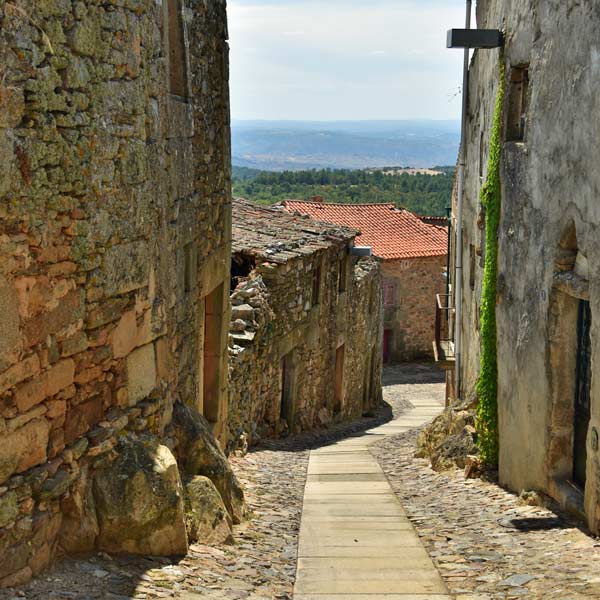
Medieval stone houses line the cobbled streets of Castelo Rodrigo
Castelo Rodrigo boasts a fascinating Jewish heritage. During the Middle Ages, there was a significant Jewish community in the village. Even today, some buildings still bear marks of this heritage, including houses with crosses carved on the door lintels, silent witnesses to the area's complex religious history.
Despite its historical importance, Castelo Rodrigo is now home to a very small permanent population, often cited as less than 100 inhabitants. This small population contributes to the village's serene and timeless atmosphere.
From its elevated position, Castelo Rodrigo offers panoramic views of the surrounding countryside, including parts of Spain.
Castelo Rodrigo is a delightful place which you will want to include in your tour of Beira. The castle ruins are the main attraction, while surrounding it are pretty cobbled streets and traditional stone buildings. Castelo Rodrigo is tiny, and can be seen in less than 1-hour, but you will want to visit to immerse yourself in its rich history and stunning views.
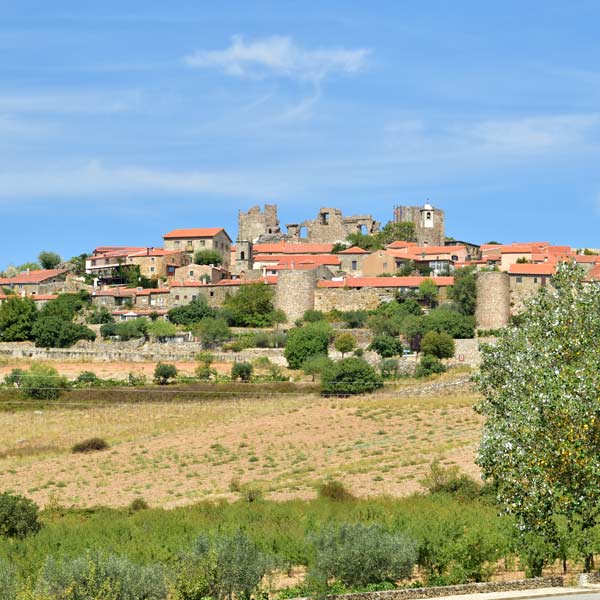
It is possible to walk around the town walls of Trancoso
Almeida
Almeida is the most impressive, fortified town in the Beira region. Its distinctive 12-pointed star-shaped defences exemplify military engineering, which can be fully appreciated when viewed from above (or with a satellite map image)
Almeida encapsulates centuries of Portuguese history within its walls. The well-preserved 17th-century fortifications allow walks along their length, offering views that span generations of conflict and peace. Six monumental gates punctuate these walls, each bearing witness to past sieges and defensive strategies.
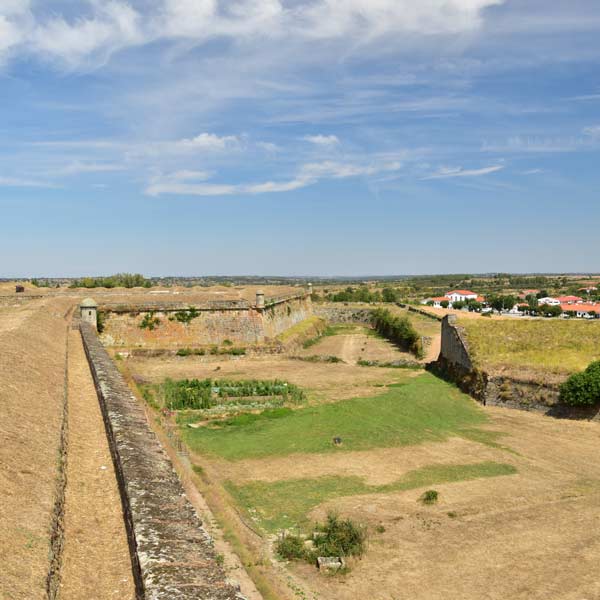
Endless moats, ditches and walls surround the Almeida
At the centre of Almeida are the remains of its medieval castle. This once formidable structure came to a dramatic end in 1810, during the Peninsular War, when its magazine exploded. The resulting ruins are a stark reminder of the town's turbulent past.
The town's narrow streets are lined with well-preserved military buildings, traditional houses and historic squares. The Military History Museum, housed in the former artillery barracks, contains exhibits detailing Almeida's strategic importance and the conflicts that shaped its development.
Almeida's double line of fortifications, complete with moats, ravelins and counter-guards, presents a comprehensive study of historical defence strategies. These architectural elements underline the town's important role in military history.
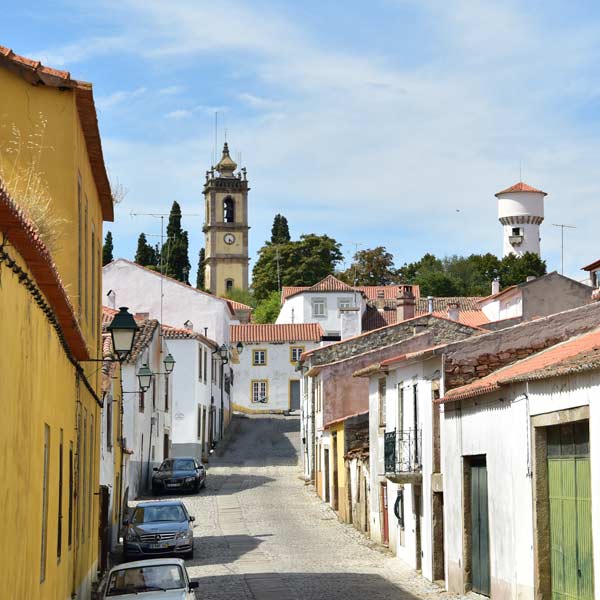
There is a pretty town to discover once through all of the defences
If you've found our content valuable, we'd welcome your support.
The digital publishing landscape has evolved significantly. As a small independent publisher, we face growing challenges. Search engines increasingly favour paid content over organic results, while AI-generated content often reproduces original work without attribution.
To support our work, please consider bookmarking this page (press Ctrl + D) for quick access. If you find an article helpful, we'd be grateful if you'd share it with friends on social media.
For specific questions, please see our Reddit community at r/LisbonPortugalTravel.
Should you notice any outdated or incorrect information, please contact us at [email protected]
Thank you for helping us continue to provide valuable content in an increasingly challenging digital environment.























